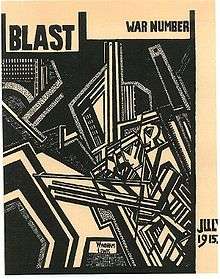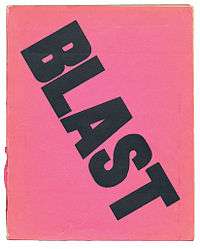Blast (magazine)
|
Cover of the first edition of Blast, 1914 | |
| Editor | Wyndham Lewis |
|---|---|
| Categories | Vorticism |
| First issue | 1914 |
| Final issue | 1915 |
| Language | English |
Blast was the short-lived literary magazine of the Vorticist movement in Britain. Two editions were published: the first on 2 July 1914 (dated 20 June 1914, but publication was delayed)[1][2] and published with a bright pink cover, referred to by Ezra Pound as the "great MAGENTA cover'd opusculus"; and the second a year later on 15 July 1915. Both editions were written primarily by Wyndham Lewis. [3] The magazine is emblematic of the modern art movement in England,[4] and recognised as a seminal text of pre-war 20th-century modernism.[5][6] The magazine originally cost 2/6.
Background
When the Italian futurist Filippo Tommaso Marinetti visited London in 1910,[7] as part of a series of well-publicised lectures aimed at galvanizing support across Europe for the new Italian avant-garde, his presentation at the Lyceum Club, in which he addressed his audience as "victims of .... traditionalism and its medieval trappings,"[8] electrified the assembled avant-garde. Within two years, an exhibition of futurist art at the Sackville Gallery, London, brought futurism squarely into the popular imagination, and the press began to use the term to refer to any forward-looking trends in modern art.

Initially galvanized by Marinetti's verve, Wyndham Lewis—like many other members of the London avant-garde—had become increasingly irritated by the Italian's arrogance.[3] The publication of the English Futurist manifesto Vital English Art, in the June 1914 edition of The Observer, co-written by Marinetti and the "last remaining English Futurist" C. R. W. Nevinson, Lewis found his name, among others, had been added as a signatory at the end of the article without permission, in an attempt to assimilate the English avant-garde for Marinetti's own ends. On 12 June, during recitations of this manifesto and a performance by Marinetti of his poem The Battle of Adrianople, with Nevinson accompanying on drums, Lewis, T. E. Hulme, Jacob Epstein, Henri Gaudier-Brzeska, Edward Wadsworth, and five others roundly interrupted the performance with jeering and shouting.[9] Wyndham Lewis wrote a few days later, "England practically invented this civilisation that Signor Marinetti has come to preach to us about".[10]
The final riposte came with the publication of Blast (later known as Blast 1), written and illustrated by a group of artists assembled by Lewis from "a determined band of miscellaneous anti-futurists".[3] The name Vorticism was coined by the poet Ezra Pound, a close friend of Lewis and the group's main publicist.[11] Writing to James Joyce in April 1914, Pound described the magazine in ambiguous terms: "Lewis is starting a new Futurist, Cubist, Imagiste Quarterly .... I cant tell, it is mostly a painters' magazine with me to do the poems".[3] By July, the magazine had a name, a movement to support, and a typographic style, and it had forged a distinctly English identity, confident enough to praise Kandinsky, question Picasso,[12] and openly mock Marinetti.
Editions
Blast 1 was edited and largely written by Wyndham Lewis with contributions from Pound, Gaudier-Brzeska, Epstein, Spencer Gore, Wadsworth, and Rebecca West and included an extract from Ford Madox Hueffer's novel The Saddest Story, better known by its later title The Good Soldier (published under his subsequent pseudonym, Ford Madox Ford). The first edition was printed in folio format, with the oblique title Blast splashed across its bright pink soft cover. Inside, Lewis used a range of bold typographic innovations and tricks to engage the reader, that are reminiscent of Marinetti's contemporary concrete poetry such as Zang Tumb Tumb. Rather than conventional serif fonts, some of the text is set in sans-serif "grotesque" fonts.[13][14][15]
The opening twenty pages of Blast 1 contain the Vorticist manifesto, written by Lewis with assistance from Pound and signed by Lewis, Wadsworth, Pound, William Roberts, Helen Saunders, Lawrence Atkinson, Jessica Dismorr, and Gaudier-Brzeska. Epstein chose not to sign the manifesto, although his work was featured. There is also a (positive) critique of Kandinsky's Concerning the Spiritual In Art, a faintly patronising exhortation to suffragettes not to destroy works of art, a review of a London exhibition of Expressionist woodcuts, and a last dig at Marinetti by Wyndham Lewis:
Futurism, as preached by Marinetti, is largely Impressionism up-to-date. To this is added his Automobilism and Nietzsche stunt, With a lot of good sense and vitality at his disposal, he hammers away in the blatant mechanism of his Manifestos, at his idee fixe of Modernity.[16]
The Manifesto

The manifesto is primarily a long list of things to be 'Blessed' or 'Blasted'. It starts:
- Beyond Action and Reaction we would establish ourselves.
- We start from opposite statements of a chosen world. Set up violent structure of adolescent clearness between two extremes.
- We discharge ourselves on both sides.
- We fight first on one side, then on the other, but always for the SAME cause, which is neither side or both sides and ours.
- Mercenaries were always the best troops.
- We are primitive Mercenaries in the Modern World.
- Our Cause is NO-MAN'S.
- We set Humour at Humour's throat. Stir up Civil War among peaceful apes.
- We only want Humour if it has fought like Tragedy.
- We only want Tragedy if it can clench its side-muscles like hands on its belly, and bring to the surface a laugh like a bomb.
[Blast 1] included the now famous pages of subjects either 'Blasted' or 'Blessed' depending on how they were seen by the fledgling Vorticists. 'Blast' pages generally had a go at [Roger] Fry, the Bloomsbury set, the average art critic, and Putney (for some reason). Amongst those being Blessed are hairdressers and mariners. The latter two professions were celebrated because they both battle against elemental nature.
Tonks, the Slade drawing tutor has the unique honour of being both 'Blessed' and 'Blasted'. —Vorticism Online[17]
The first edition also contained many illustrations in the Vorticist style by Jacob Epstein, Lewis and others.
The second edition, published on 20 July 1915, contained a short play by Ezra Pound and T. S. Eliot's poems Preludes and Rhapsody on a Windy Night. Another article by Gaudier-Brzeska entitled Vortex (written from the Trenches) further described the vorticist aesthetic. It was written whilst Gaudier-Brzeska was fighting in the First World War, a few weeks before he was killed at Verdun.
World War I and the end of Vorticism
Thirty-three days after Blast 1 was published, war was declared on Germany. The First World War would destroy vorticism;[18] both Gaudier-Brzeska and T. E. Hulme were killed at the front, and Bomberg lost his faith in modernism.[19] Lewis was mobilised in 1916, initially fighting in France as an artillery officer, later working as a war artist for the Canadian Government. He tried to re-invigorate the avant-garde after the war, writing to a friend that he intended to publish a third edition of Blast in November 1919.[20] He organised an exhibition of avant-garde artists called Group X[21] at Heal's Gallery in March–April 1920, and later published a new magazine, The Tyro, of which only two issues appeared.[22] The further issue of Blast failed to appear, and neither of the other two ventures managed to achieve the momentum of his pre-war efforts. Richard Cook writes:
When Lewis returned from the trenches, he hoped to revivify the Vorticist spirit, planning a third issue of Blast and regaining contact with old allies. But the whole context of pre-war experimentation had been dispersed by the destructive power of mechanized warfare, which persuaded most of the former Vorticists to pursue more representational directions thereafter. By 1920 even Lewis was obliged to admit that the movement was dead.[18]
Public collections
Both editions have been reprinted a number of times and are shortly to be made available again by Thames and Hudson; original copies are in the collections of the Victoria and Albert Museum, Tate, Yale University, Wake Forest University, University of Delaware, Chelsea College, and others. The Nasher Museum of Art at Duke University held an exhibition entitled The Vorticists: Rebel Artists in London and New York, 1914–18 from 30 September 2010, through 2 January 2011.[23]
Notes
- ↑ Black (2004), p. 100
- ↑ see page 1 of Blast or Humphrey Carpenter's A Serious Character: The Life of Ezra Pound, p. 249
- 1 2 3 4 Pfannkuchen (2005)
- ↑ "Vorticism.co.uk". Vorticism.co.uk. Retrieved 2009-08-17.
- ↑ Jackie Klein, Guardian Online
- ↑ "University of Delaware Library". Lib.udel.edu. Retrieved 2009-08-17.
- ↑ For a part of this speech, se Wikiquotes, Filippo Tommaso Marinetti
- ↑ Lyon (1999), p. 97
- ↑ Black (2004), p. 100
- ↑ Wyndham Lewis, quoted in Pfannkuchen (2005)
- ↑ "Vorticism Online". Vorticism.co.uk. Archived from the original on 7 March 2009. Retrieved 17 August 2009.
- ↑ "These wayward little objects have a splendid air, starting up in pure creation, with their invariable and lofty detachment from any utilitarian end or purpose. But they do not seem to possess the necessary physical stamina to survive, You feel the glue will come unstuck and that you would only have to blow with your mouth to shatter them" Relativism and Picasso's Latest Work, Lewis, quoted in Blast 1, p. 139
- ↑ Yiannakopoulou, Konstantina. "How BLAST magazine has changed literature". Typeroom. Retrieved 9 October 2016.
- ↑ Mattern, Isabelle. "U5 #3 – Blast/Bless: Grotesque No. 9". Isabelle Mattern (blog). Retrieved 9 October 2016.
- ↑ Mattern, Isabelle. "Blast/Bless: Grotesque No. 9". Isabelle Mattern (blog). Retrieved 9 October 2016.
- ↑ Lewis, The Melodrama of Modernity, Blast 1 p. 143
- ↑ "Blast". Vorticism.co.uk. Archived from the original on 6 February 2009. Retrieved 17 August 2009.
- 1 2 Vorticism, an essay by Richard Cook, Oxford Art Online
- ↑ "[Bomberg's] disillusion with the destructive power of the machine at war led to a few years spent experimenting with ways of making his stark pre-war style more rounded and organic." Quoted from the essay on Bomberg by Richard Cork, Oxford Art Online
- ↑ Quoted in Black (2004), p. 102
- ↑ Participating artists were Dismorr, Dobson, Etchells, Ginner, Hamilton, Lewis, Roberts, McKnight Kauffer, Turnbull and Wadsworth
- ↑ "Tate Online". Tate.org.uk. Retrieved 2009-08-17.
- ↑ Nasher Museum Retrieved 17 September 2010
References
- Black, Jonathan (2004). Blasting the Future: Vorticism and the Avant-Garde in Britain 1910–20. Philip Wilson Publishers. ISBN 978-0-85667-572-0
- Lewis, Wyndham ed. (1914) Blast, issue 1. London: Bodley Head.
- Lewis, Wyndham ed. (1915) Blast, issue 2. London: Bodley Head.
- Lyon, Janet (1999). Manifestoes: Provocations of the Modern. Cornell University Press. ISBN 978-0-8014-3635-2. (Excerpt at Google Books)
- Pfannkuchen, Antje (2005). From Vortex To Vorticism: Ezra Pound's art and science. Online via Goliath and Highbeam.
Facsimile editions of "Blast"
- 1982. Santa Rosa: Black Sparrow Press. ISBN 978-0-87685-521-8.
- 2009. London: Thames & Hudson. ISBN 978-0-500-28782-8.
Further reading
- Beckett, Jane (2000). Blast: Vorticism, 1914–1918. Ashgate Publishing. ISBN 978-1-84014-647-9
- Bury, Stephen (2007). Breaking the Rules: The Printed Face of the European Avant Garde 1900–1937. London: British Library. ISBN 978-0-7123-0980-6
- Orchard, Karin ed. (1996). Blast: Vortizismus – die erste Avantgarde in England 1914–1918. Berlin: Ars Nicolai. ISBN 978-3-89169-105-2
External links
- Vorticism Online
- Blast 1 (1914) at the Modernist Journals Project
- Blast 1 pdf
- Blast 2 (1915) at the Modernist Journals Project
- Blast 2 pdf
- 9 August 1914, The New York Times VORTICISM THE LATEST CULT OF REBEL ARTISTS; It Goes a Step Further Than Cubism and Futurism, and Is Sponsored by Brzeska, Epstein and Others. Its Official Mouthpiece Is a Cerise Magazine Called Blast.

